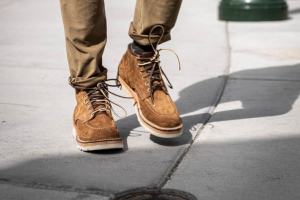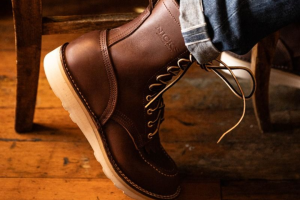Plantar Fasciitis, Boot Design And You
One of the most common foot injuries or conditions is plantar fasciitis. It can occur for a number of reasons, but one of the most common is actually wearing the wrong footwear for your feet.
Bear in mind that we aren't doctors and you need to talk to a podiatrist (that's a foot doctor) if you want real medical advice about feet. And we're only going to talk about what's already widely known and accepted when it comes to footwear.
What the best plantar fasciitis boots are - meaning boots that avoid it or can keep it from happening - has more to do with you than anything. It's what boots are best for YOUR feet.
What Is Plantar Fasciitis?
Plantar Fasciitis is pain that comes from your plantar fascia, which is the connective tissue in the arch of the foot.
The plantar fascia runs from the middle of the heel all the way to the underside of the toes, basically acting like a rubber band that stretches and contracts as your foot moves.
Plantar fasciitis, also called "policeman's heel," can happen due to a number of different causes, but it always manifests itself as heel pain. It can be hard to distinguish whether you have a bruise on the heel (if you walk or do more than you normally do in a day) or have plantar fasciitis.
What is coming to be understood is that the cause isn't inflammation, but it usually comes from either overuse or underuse of the plantar fascia.
We aren't meant to sit all day, and those who develop it often have desk jobs and sedentary lifestyles. However, plenty of people who don't drive a desk and are on their feet all day, every day, develop it too.
What role, if any, does your choice in footwear have to do with plantar fasciitis?
A Common Cause Of Plantar Fasciitis Is High Arches
One of the most common associated conditions with getting plantar fasciitis is having high arches.
People with high arches typically need more support in the arch of their foot. While arch support is important for everyone, some people need more of it, and if you have high arches you've probably spent a lot of money on arch support inserts over the years.
Typically, arch issues require either all but going barefoot to let the foot stretch and flatten out more or you have to get a sturdy pair of leather shoes or work boots that have extra material in the footbed and a sturdy heel to support the arch of your foot.
Unless you're totally barefoot (or as close to it as you can get) and the foot can flex and stretch to accommodate for the high arch, you need the material to support it. Without the extra support in the arch, the plantar fascia has to work harder and thus you get a strain from overuse.
Again, how that commonly manifests itself is heel pain.
What a lot of people will tell themselves is that they're just "not used" to being on their feet, but that's not really true; the heel bone doesn't harden or soften with use, and there's not much skin or muscle between the heel and the bottom of the foot to begin with.
Now it CAN be true that a pair of shoes or boots doesn't absorb enough impact when you're walking, but if you're still getting heel pain despite wearing sturdy boots...it's probably not because your boots aren't broken in, or because you need to get used to them.
A lot of the time, it's because you don't have enough arch support.
What Are The Best Plantar Fasciitis Boots For Me?
If you have chronic or recurring plantar fasciitis, the first thing is to speak to a doctor. You should visit an orthopedist or podiatrist, who can accurately diagnose what's going on with your feet.
As far as what boots are best, the general rule is the higher the arch, the more support you need, and that means figuring out what YOUR feet's arches are like.
Ever look at your footprint walking around a pool? The more foot you see between your instep and the outside edge of your foot, the lower your arch is.
The best way to find out is to get your feet measured.
Specialty shoe shops, or even those Dr. Scholls custom insert machines that they have in a lot of stores can measure your feet and give you an idea of what your arch profile is like.
There are also some high-end boot and shoe makers that will measure your feet so you can <a href="https://nicksboots.com/company/sizing-guide/">be fit for custom boots</a> made for you.
Once you get your feet measured, you can start addressing it from there. The best thing to do, of course, is to have your shoes or boots made for your feet, as then you'll have the fit and support that you need, rather than having to hope a pair of factory boots will work.
One of the most common foot injuries or conditions is plantar fasciitis. It can occur for a number of reasons, but one of the most common is actually wearing the wrong footwear for your feet.
Bear in mind that we aren't doctors and you need to talk to a podiatrist (that's a foot doctor) if you want real medical advice about feet. And we're only going to talk about what's already widely known and accepted when it comes to footwear.
What the best plantar fasciitis boots are - meaning boots that avoid it or can keep it from happening - has more to do with you than anything. It's what boots are best for YOUR feet.
What Is Plantar Fasciitis?
Plantar Fasciitis is pain that comes from your plantar fascia, which is the connective tissue in the arch of the foot.
The plantar fascia runs from the middle of the heel all the way to the underside of the toes, basically acting like a rubber band that stretches and contracts as your foot moves.
Plantar fasciitis, also called "policeman's heel," can happen due to a number of different causes, but it always manifests itself as heel pain. It can be hard to distinguish whether you have a bruise on the heel (if you walk or do more than you normally do in a day) or have plantar fasciitis.
What is coming to be understood is that the cause isn't inflammation, but it usually comes from either overuse or underuse of the plantar fascia.
We aren't meant to sit all day, and those who develop it often have desk jobs and sedentary lifestyles. However, plenty of people who don't drive a desk and are on their feet all day, every day, develop it too.
What role, if any, does your choice in footwear have to do with plantar fasciitis?
A Common Cause Of Plantar Fasciitis Is High Arches
One of the most common associated conditions with getting plantar fasciitis is having high arches.
People with high arches typically need more support in the arch of their foot. While arch support is important for everyone, some people need more of it, and if you have high arches you've probably spent a lot of money on arch support inserts over the years.
Typically, arch issues require either all but going barefoot to let the foot stretch and flatten out more or you have to get a sturdy pair of leather shoes or work boots that have extra material in the footbed and a sturdy heel to support the arch of your foot.
Unless you're totally barefoot (or as close to it as you can get) and the foot can flex and stretch to accommodate for the high arch, you need the material to support it. Without the extra support in the arch, the plantar fascia has to work harder and thus you get a strain from overuse.
Again, how that commonly manifests itself is heel pain.
What a lot of people will tell themselves is that they're just "not used" to being on their feet, but that's not really true; the heel bone doesn't harden or soften with use, and there's not much skin or muscle between the heel and the bottom of the foot to begin with.
Now it CAN be true that a pair of shoes or boots doesn't absorb enough impact when you're walking, but if you're still getting heel pain despite wearing sturdy boots...it's probably not because your boots aren't broken in, or because you need to get used to them.
A lot of the time, it's because you don't have enough arch support.
What Are The Best Plantar Fasciitis Boots For Me?
If you have chronic or recurring plantar fasciitis, the first thing is to speak to a doctor. You should visit an orthopedist or podiatrist, who can accurately diagnose what's going on with your feet.
As far as what boots are best, the general rule is the higher the arch, the more support you need, and that means figuring out what YOUR feet's arches are like.
Ever look at your footprint walking around a pool? The more foot you see between your instep and the outside edge of your foot, the lower your arch is.
The best way to find out is to get your feet measured.
Specialty shoe shops, or even those Dr. Scholls custom insert machines that they have in a lot of stores can measure your feet and give you an idea of what your arch profile is like.
There are also some high-end boot and shoe makers that will measure your feet so you can be fit for custom boots made for you.
Once you get your feet measured, you can start addressing it from there. The best thing to do, of course, is to have your shoes or boots made for your feet, as then you'll have the fit and support that you need, rather than having to hope a pair of factory boots will work.




